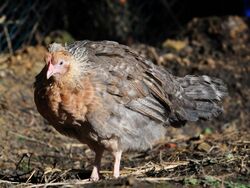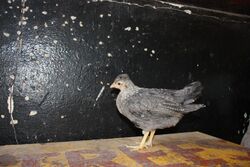Biology:Legbar
 | |
| Conservation status | |
|---|---|
| Country of origin | United Kingdom |
| Use | eggs |
| Traits | |
| Weight |
|
| Egg colour |
|
| Comb type | single, large |
| Classification | |
| APA | no[5] |
| EE | no[6] |
| PCGB | soft feather: light[7] |
| |
The Legbar is a rare British auto-sexing breed of chicken. It was created in the early twentieth century by Reginald Crundall Punnett and Michael Pease at the Genetical Institute of Cambridge University.[8]:318 They cross-bred American barred Plymouth Rock birds with brown Leghorns and created the gold and silver colour varieties. Pease created a cream Legbar by cross-breeding these with white Leghorns; later crossing with Araucanas caused this to have a crest and to lay blue or blue-green eggs.[9]:60
History
The Legbar was the second auto-sexing chicken breed created by Reginald Crundall Punnett and Michael Pease at the Genetical Institute of Cambridge University, after the Cambar, which was created in 1929 by crossing barred Plymouth Rock with gold Campine birds.[8]:318[10]:270[11]:53
The Legbar arose from cross-breeding of Plymouth Rock birds with brown Leghorns, which at that time were two of the principal egg-laying breeds. As with the Cambar, they set out to breed a bird that would both have brown down and carry the barred gene (B), so that chicks would have sex-linked plumage differences that could easily be distinguished.[9]:53[8]:317 Standards for the gold and silver colour varieties were drawn up in 1945 and 1951 respectively.[12]
The cream Legbar was created by chance. Through cross-breeding of gold Legbars with white Leghorn stock, Pease had obtained some cream-coloured birds; their eggs were white, and they had no crest. An experimental crossing of these with some cream-coloured Araucanas from Punnett's laboratory led to the creation of the cream Legbar, a crested layer of coloured eggs for which a standard was drawn up in 1958.[9]:53[4][13]:193 Within a short time it became very rare, but has since recovered.[4] It is treated by the Poultry Club of Great Britain as a colour variety of the Legbar,[9]:53 but is considered by the Rare Breed Survival Trust to be a separate breed.[4] Both the Legbar and the Cream Legbar are listed among the UK breeds on the watchlist of the trust; neither is considered "priority".[14]
Characteristics
The Legbar has three colour varieties: gold, silver and cream.[15] The cream variant has a crest and lays blue, olive or green eggs.[11]:53 The Legbar is considered a rare breed by the Poultry Club of Great Britain and, until the Autosexing Breeds Association was re-formed, fell under the Rare Poultry Society.[9]:60[16]
Use
The Legbar was bred as an auto-sexing layer breed. Hens may give 180 eggs or more per year.[12]
References
- ↑ Native Poultry Breeds at Risk. Rare Breeds Survival Trust. Archived 1 July 2014.
- ↑ Watchlist overview. Rare Breeds Survival Trust. Archived 22 November 2021.
- ↑ Breed data sheet: Legbar / United Kingdom of Great Britain and Northern Ireland (Chicken). Domestic Animal Diversity Information System of the Food and Agriculture Organization of the United Nations. Accessed January 2022.
- ↑ 4.0 4.1 4.2 4.3 Cream Legbar. Rare Breeds Survival Trust. Archived 27 December 2016.
- ↑ APA Recognized Breeds and Varieties: As of January 1, 2012. American Poultry Association. Archived 4 November 2017.
- ↑ Liste des races et variétés homologuée dans les pays EE (28.04.2013). Entente Européenne d’Aviculture et de Cuniculture. Archived 16 June 2013.
- ↑ Breed Classification. Poultry Club of Great Britain. Archived 12 June 2018.
- ↑ 8.0 8.1 8.2 F.A.E. Crew (1967). Reginald Crundall Punnett. 1875–1967. Biographical Memoirs of Fellows of the Royal Society 13: 309-326. (Subscription content?)
- ↑ 9.0 9.1 9.2 9.3 9.4 J. Ian H. Allonby, Philippe B. Wilson (editors) (2018). British Poultry Standards: complete specifications and judging points of all standardized breeds and varieties of poultry as compiled by the specialist breed clubs and recognised by the Poultry Club of Great Britain, seventh edition. Chichester; Hoboken, New Jersey: Wiley Blackwell. ISBN:9781119509141.
- ↑ Francis H.A. Marshall, Edward Thomas Halnan (1946 [1920]). Physiology of farm animals, fourth edition. Cambridge: The University Press.
- ↑ 11.0 11.1 Victoria Roberts (2008). British poultry standards: complete specifications and judging points of all standardized breeds and varieties of poultry as compiled by the specialist breed clubs and recognised by the Poultry Club of Great Britain. Oxford: Blackwell. ISBN:9781405156424. p. 53-56
- ↑ 12.0 12.1 Legbar. Rare Breeds Survival Trust. Archived 27 December 2016.
- ↑ Sophie McCallum (2020). Rare British Breeds: Endangered Species in the UK. Yorkshire; Philadelphia: Pen & Sword Books Limited. ISBN 9781526763631.
- ↑ Watchlist 2021–22. Rare Breed Survival Trust. Archived 22 November 2021.
- ↑ The Autosexing Breeds. Autosexing Breeds Association. Archived 25 March 2023.
- ↑ The Breeds We Cover. The Rare Poultry Society. Archived 7 August 2013.
 |



